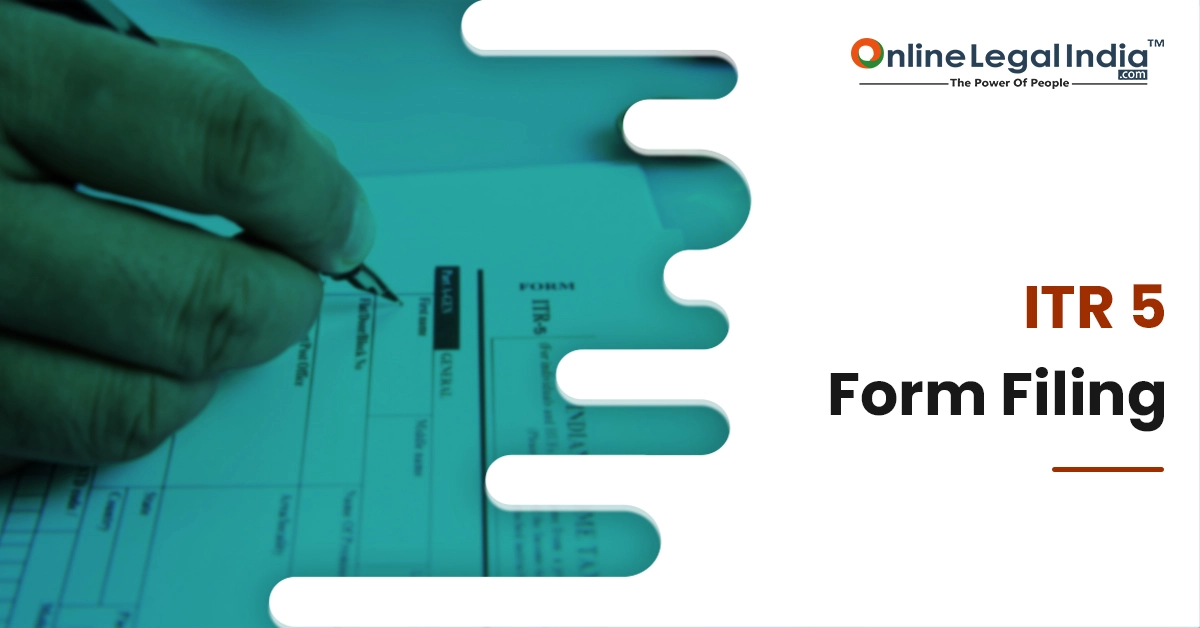How to Register a Brand Name
17 Apr, 2024

 By Online Legal India
Published On 15 Nov 2022
Updated On 17 Jan 2023
Category Income Tax
By Online Legal India
Published On 15 Nov 2022
Updated On 17 Jan 2023
Category Income Tax
Filing an income tax return is a duty and a requirement for all citizens of the nation. The Income Tax Return is the document on which an assessee fills out all his income and tax information and submits it to the Income Tax Department. ITR forms include Income Tax Return 1 Sahaj, Income Tax Return 2, Income Tax Return 3, Income Tax Return 4, Income Tax Return 5, Income Tax Return 6, and Income Tax Return 7. Every assessee should be aware of and select a suitable ITR form for submitting tax returns based on his income and occupation. Income Tax Return or ITR 5 Form is an Income Tax Return form that some particular parties must utilise.
This income tax return is intended for businesses, LLPs, the Association of Persons and Body of Individuals, Artificial Juridical Persons, the Estate of a Dead Person, the Estate of an Insolvent Person, Business Trust, and Investment Fund.
From AY 2013-14 onwards, if an assessee is required to provide an audit report under sections 10(23C)(iv), 10(23C)(v), 10(23C)(vi), 10(23C)(via), 10A, 10AA, 12A(1)(b), 44AB, 44DA, 50B, 80-IA, 80-IB, 80-IC, 80-ID, 80JJAA, 80LA, 92E, 115JB.
A person who is a firm, LLP, AOP, BOI, an artificial juridical person described in section 2(31)(vii), the estate of the dead, the estate of insolvent, business trust & investment fund, cooperative society, and local authority can use this form. However, a person who is obligated to file for an income tax return under sections 139(4A), 139(4B), 139(4C), or 139(4D) may not utilise this form.
The primary alterations in the ITR 5 form are as follows:
The primary alterations in the ITR 5 form are as follows:
The primary alterations in the ITR 5 form are as follows:
Part A: General Information
Part A-BS: Balance Sheet as of March 31, 2019.
Part A: Manufacturing Account for the 2018-19 fiscal year
Part A: Trading Account for the 2018-19 fiscal year
Part A-P&L: Profit and Loss Statement for the Fiscal Year 2018-19
Part A-OI: Additional information
Part A-QD: Quantitative information
This ITR 5 form filing must be submitted to the Income Tax Department online in the following ways:
When filing the return online, the assessee should print two copies of the ITR-5 Form. One copy of the ITR-5, fully signed by the assessee, must be mailed to Post Bag No. 1, Electronic City Office, Bengaluru-560500 (Karnataka).
The assessee may keep the other copy for his records. A business whose finances are subject to audit under section 44AB shall submit the return electronically using a digital signature.
When submitting the ITR-5 form, no documents (including TDS certificates) should be attached. All such papers will be separated from this Return Form and returned to the person submitting the return. It is recommended that taxpayers match the taxes deducted/collected/paid by or on their behalf with their Tax Credit Statement Form 26AS.
1. Details of advance tax and self-assessment tax payment
2. Details of tax deducted at source on non-salary income (16A, 16B, 16C)
3. Source data collection details
Taxpayers must file Income Tax returns depending on the income produced during the fiscal year and the kind of company under which it falls. The Association of Persons, Limited Liability Partnerships, Body of Individuals, Estates of the deceased, Artificial judicial person, business trust, estates of the insolvent, business trust, and investment fund must ITR 5 Form filing.

How to Register a Brand Name
17 Apr, 2024

How Can You Download FSSAI Certificate?
15 Apr, 2024

Copyright a Business Name Know the Procedure
13 Apr, 2024

Top 10 Law Firms in India
11 Apr, 2024

Top 7 Advantages of Trademark Registration
03 Apr, 2024

Consumer Complaint against Tamil Nadu Electricity Board TNEB
30 Nov, 2020

How to Take Legal Action against Mental Harassment in India?
07 Nov, 2020

UPPCL Uttar Pradesh Power Corporation Ltd. Complaint Filing
19 Nov, 2020

How to File a Complaint Online in Consumer Court in India
27 Nov, 2020

Online Complaint Filing against Hero Motocorp
04 Dec, 2020